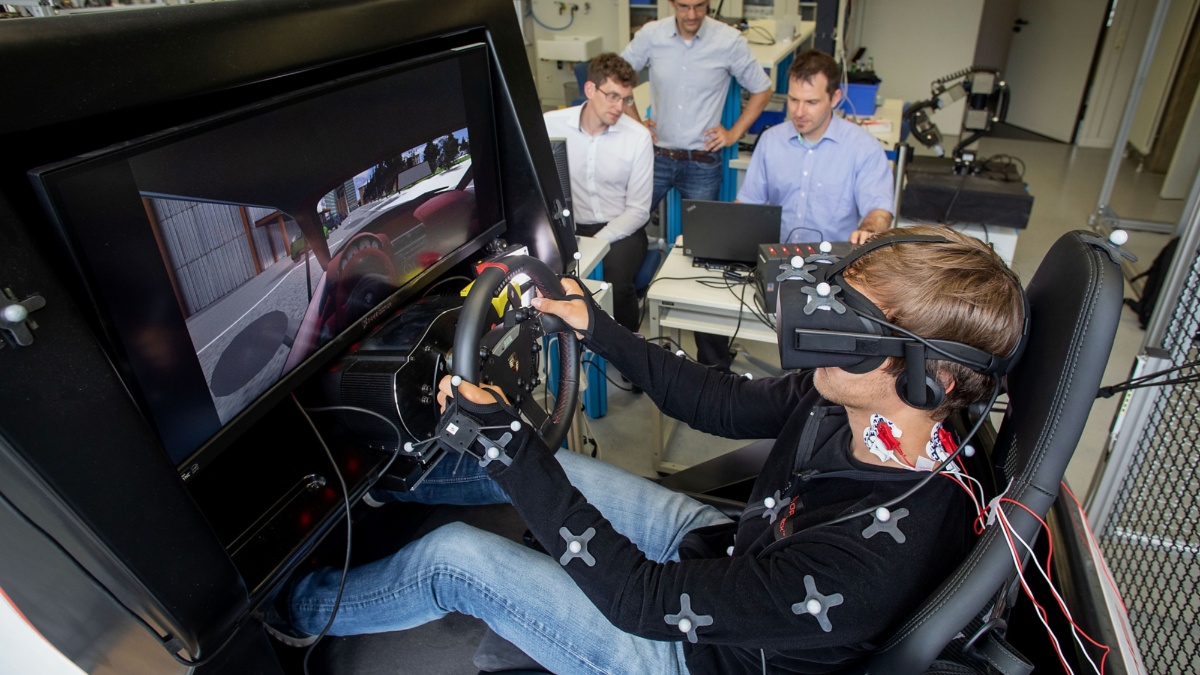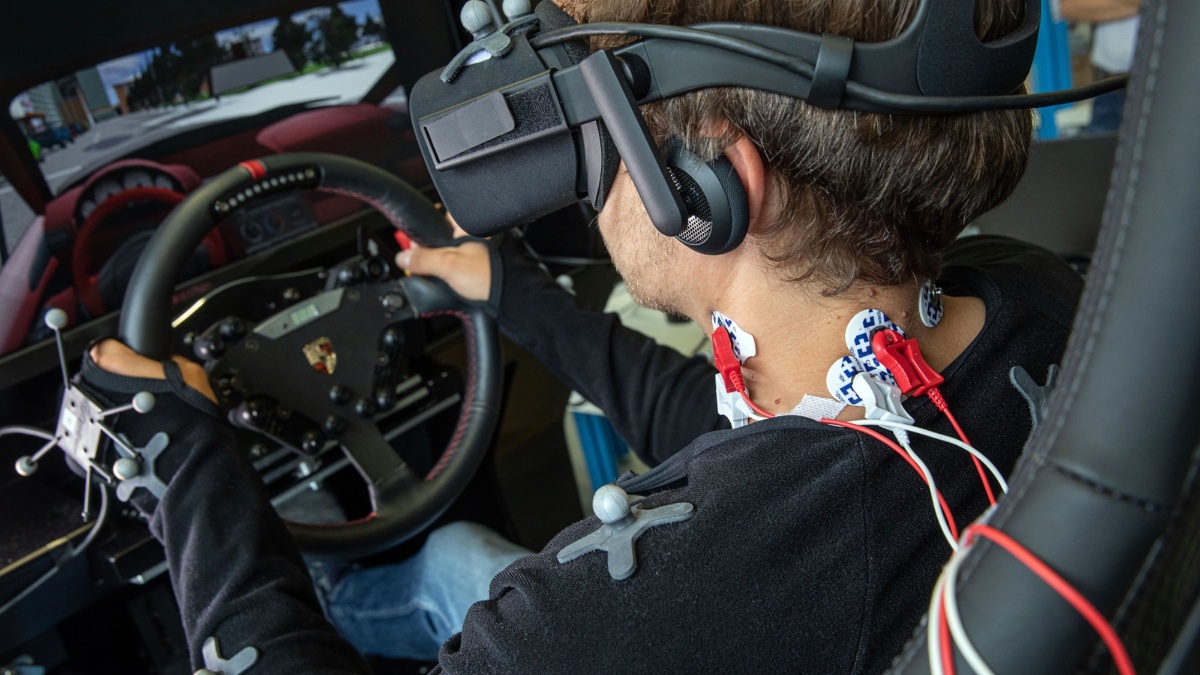
A crash test is an impressive experience: whenever a vehicle crashes into the wall, it shakes up the sensor-laden dummies inside the vehicle pretty severely. For a long time now, tests such as these have not only been performed in real life, but also in computer simulations, which include virtual dummies. Crashes involving vehicles made up of bits and bytes save a lot of time and money, but whilst the vehicles modelled in these simulations are replicated in an extremely realistic manner, the virtual dummies are still what they already are in real-life crash tests – incomplete approximations of the human body. What this means is that, although the weight, dimensions and rigidity of the individual body parts correspond to those of the average population, they do not come close to the complexity of the human locomotor system – neither in real-life nor in virtual tests or, to put it bluntly dummies don’t have muscles.
"This means that vehicles cannot be developed in a human-centered way," says Prof. Syn Schmitt, head of the Institute for Modelling and Simulation of Biomechanical Systems and researcher at the University of Stuttgart’s "Stuttgart Center for Simulation Science" (SimTech) cluster of excellence.
Yet there are three good reasons for placing humans at the center of vehicle development: first, future safety systems should provide even better protection for vehicle occupants, particularly during the immediate pre-collision phase and with regard to non-life-threatening injuries.
A person’s actual stature plays a decisive role, for example, because it makes a difference if the person involved is a lightweight of 50 kilograms or weighs 150 kilograms. Second, these occupants will no longer necessarily occupy the classic seating positions when emergency braking occurs in autonomous vehicles; they might be dozing with thebacks of their seats folded back or be sitting with their backs to the direction of travel. Third, any such autonomous car must be able to detect whether a pedestrian is about to cross the road abruptly. Currently, this person is perceived by the on-board systems as little more than a silhouette from which the intended movement is difficult to derive.
Converging on real-life movements
As the results of real crash tests published by the ADAC [de] this spring, for example make clear, none of this is purely theoretical. According to these results, today's three-point seatbelts offer no protection to passengers in rear-facing or recumbent positions; sitting sideways can also result in injuries, even from the seatbelt itself.
"We need better digital human models to assess the risks that will be involved in future driving situations," says Schmitt. "Better", in this context, means human models that not only includes bones and the correct mass distribution, but also muscles and tendons, because these are the main factors that determine posture and movement. Schmitt and his team are developing such human models. Like all simulation models, a human model is basically a set of mathematical equations, which in this case describe interactions within the musculoskeletal system. Human beings have 656 muscle-tendon units of which Schmitt's most complex model takes account of 580, "all except those in the face, fingers and hands". Such human models are not only of interest to the automotive industry, but also for such fields as medicine and medical technology.
"Our human model is stored in a database," Schmitt explains. "To answer specific questions,” he continues, “we often use just that part of the model that is particularly relevant to the movement under investigation, which may be an arm or the legs.” Human movement “results from the interplay between the brain and nervous system with muscles and the musculoskeletal system. It is not possible, at present, to depict this interaction in the digital human model on a one-to-one basis, because it is far too complex and not yet fully understood, which is why Schmitt's team is developing mathematical descriptions that reflect the real movements as closely as possible.
The team is creating the basis for integrating such digital human models into future crash simulation systems within the framework of the EU’s OSCCAR project, among others. The 3-year OSCCAR project which has a budget of just under 7.7 million euro, involves some 20 partners from industry and the research community, including Bosch, Daimler, Siemens, Toyota, Volkswagen and Volvo, and is due to end in June 2021. The digital human models developed during the project are to take into account specific characteristics relating, for example, to gender and age and will incorporate improved material properties and should be capable of simulating the muscular movements of pedestrians, drivers and passengers in hazardous situations.
"This applies to such postures as standing and sitting, but also to the movements that occur during braking, steering and swerving," says Schmitt. "Commercially available human models still can't do that and are practically static."
Validation is essential
present the thing as accurately as possible, which is done, for example, using real data from experiments with volunteers. This is where Prof. Jörg Fehr, Deputy Director of the University of Stuttgart’s Institute of Engineering and Computational Mechanics (ITM) comes in; like Schmitt, he is also a researcher at the SimTech Cluster of Excellence. During his doctoral studies, Fehr had a driving simulator with an appropriate mensuration sequence developed and set up at the ITM.
"There are much more powerful driving simulators, even at our university," says Fehr, "but our simulator can demonstrate ways of validating digital human models in a very cost-effective manner. This also enables us to introduce students to complex scientific issues." To carry out the tests, his team collaborates with Prof. Tobias Siebert and Privatdozent Norman Stutzig of the Institute of Sports Science and Kinesiology (INSPO). One of the central themes of their research is the further development of muscle models to better represent muscle forces in highly dynamic accident situations. "The INSPO team measures the muscle tension in the test subjects within the driving simulator, whereas we expose them to various traffic situations and analyze their movements," explains Fehr.
Towards more individual protection
One relevant question in this context is what changes take place in test subjects’ musculoskeletal system, when forced to brake abruptly? It is well known that people who see a collision coming, reflexively tense their muscles to protect their bodies, a fact which has not yet been taken into account in virtual crash simulations, and especially not the fact that a well-trained 20-year-old might protect his or herself better than a feeble 80-year-old. "Our current safety systems only protect the average passenger, not the individual, whose stature, musculature and reactional behavior are specific and particular," says Fehr. The varied behaviors of real people can be studied in the simulator and then integrated into the digital human models.
The following step involves extensive testing with several dozen volunteers in the simulator. "The digital human models provide numerous parameters and thus different ways to describe movements," says Fehr, explaining the basic problem that he hopes to solve through validation. It is often unclear how exactly muscles are controlled, because the control path is often non-linear, and basically involve tiny control signals that trigger major changes, but which cannot be identified in a causally isolated manner as part of the movement as a whole. So, to some extent, the emergence of the movement remains misunderstood.
But more importantly, one cannot play through all conceivable scenarios, because there are simply too many. "On the other hand,” says Fehr, “the real data from the driving simulator helps us to narrow down the parameters for describing motion in the human model."
Artificial intelligence and digital muscles
Schmitt and his team also attempt to do this in other ways. One new approach, the essential feasibility of which they recently demonstrated, is based on artificial intelligence (AI). "We no longer need to understand the exact cause of movement in a given muscle group, but simply use machine learning to recognize patterns," said Schmitt. In the digital model of the arm, for example, an algorithm could run through all the movement control parameters and would then receive feedback on whether its result is correct or not, and would gradually learn which values to assign to the parameters. According to Schmitt’s vision: “it will be possible at some point to integrate complex motion sequences into simulations that the digital human models would have previously learned themselves,” at which point AI and digital muscles would simulate real movements with near perfection.
Editor: Michael Vogel









